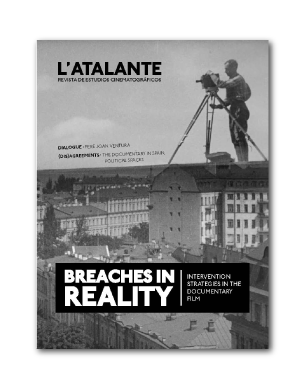Hollywood and the Shaping of the Official Story: The Second World War According to the Documentary Series 'Why We Fight' (Frank Capra, 1942-1945)
Published 2016-07-31
Keywords
- Frank Capra,
- Hollywood,
- Second World War,
- Documentary,
- Propaganda
- Official Story. ...More
How to Cite
Copyright (c) 2016 L'Atalante. Journal of film studies

This work is licensed under a Creative Commons Attribution-NonCommercial-NoDerivatives 4.0 International License.
Abstract
After Japan bombed Pearl Harbor, the United States government implemented a new system of propaganda that sought to convince American soldiers and average citizens alike of the necessity to enter World War II. This system counted on the participation of top Hollywood filmmakers, who filmed documentaries that shaped war as a narrative. Among these distinguished filmmakers, Frank Capra, author of the Why We Fight series, emerged as the most prolific propaganda cineaste of his time. This article analyzes how, through the use of documentary cinema, the US government and Frank Capra created a narration of World War II in the Why We Fight documentary series by careful manipulation, omission, and simplification of historical events in order to shape the official story of the conflict.
Downloads
References
Barsam, Richard M. (1975). <em>Filmguide to Triumph of the Will</em>. Bloomington: Indiana University Press.<br>
Bodnar, John (2010). <em>The “Good War” in American Memory</em>. Baltimore: The John Hopkins University Press.<br>
Bohn, Thomas (1977). <em>An Historical and Descriptive Analysis of the “Why We Fight Series”. </em>Nueva York: Arno Press.<br>
Capra, Frank (1971). <em>The Name Above the Title: An Autobiography</em>. Nueva York: Macmillan.<br>
Culbert, David (1983). ‘Why We Fight’: Social Engineering for a Democratic Society at War. En K. Short (ed.), <em>Film and Radio Propaganda in World War II</em> (pp. 173-191). Knoxville: The University of Tennessee Press.<br>
Doherty, Thomas (1993). <em>Projections of War: Hollywood, American Culture and World War II</em>. Nueva York: Columbia University Press.<br>
Girona, Ramón (2007). Estados Unidos en guerra. Why We Fight de Frank Capra. La Historia al servicio de la causa aliada<em>. Archivos de la Filmoteca</em>, nº 55, 41-57.<br>
Gunter, Matthew C. (2012). <em>The Capra Touch: A Study of the Director’s Hollywood Classics and War Documentaries, 1934-1945.</em> Jefferson: McFarland & Company.<br>
Harris, Mark (2014). <em>Five Came Back: A Story of Hollywood and the Second World War</em>. Nueva York: Penguin Books.<br>
Koppes, Clayton R. y Black, Gregory D. (1987). <em>Hollywood Goes to War: How Politics, Profits and Propaganda Shaped World War II Movies.</em> Nueva York: The Free Press.<br>
Levy, Bill (1998). <em>John Ford: A Bio-bibliography</em>. Westport: Greenwood Press.<br>
Mcbride, Joseph (2011). <em>Frank Capra: The Catastrophe of Success</em>. Jackson: University Press of Mississippi. <br>
Moss, Marilyn Ann (2004). <em>Giant: George Stevens, a Life on Film</em>. Madison: The University of Wisconsin Press.<br>
Patterson, Ian (2007). <em>Guernica and Total War</em>. Cambridge: Harvard University Press.<br>
Rollins, Peter C. (1996). Frank Capra’s Why We Fight Series and Our American Dream. <em>Journal of American Culture</em>, 19, nº 4, 81-86.<br>
Springer, Claudia (1986). Military Propaganda: Defense Department Films From World War II and Vietnam. <em>Cultural Critique</em>, nº 3, 151-167.</p>
</body>

